Air bomb Mk 2 Alpha (Rhodesia)
At the time of independence, the arsenal of Rhodesia had bombs of several types of foreign production. During the exercises and military operations, it was found that the available ammunition does not fully correspond to the terrain features. It turned out that medium- and large-caliber high-explosive fragmentation bombs manage to burrow into soft soil before the explosion, which is why the shock wave and fragments go mostly up and therefore cannot hit ground targets. In addition, tough South African bushes in some situations could protect the enemy from low-energy fragments. So the Air Force needed a new weaponscorresponding to the features of the region.
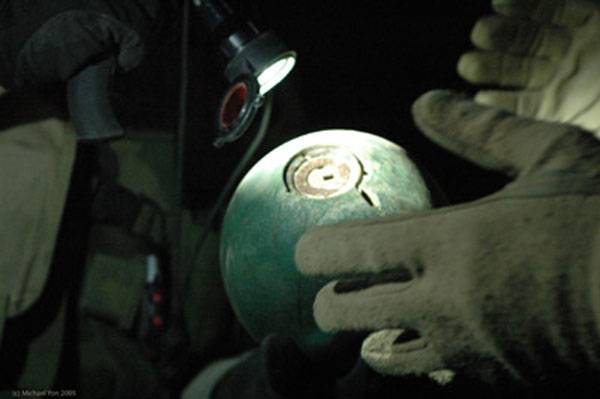
Bomb Mk 2 Alpha from the arsenals of the Iraqi army. Photo Michaelyon-online.com
In the early seventies, the Rhodesian industry created the fragmentation bomb Mk 1. This product had a significant similarity with existing bombs, but, unlike them, could only explode when it touched the ground. This possibility was provided by another fuse and a modified form of the head part. Undermining on the surface of the ground dramatically increased the effectiveness of the combat work of aviation. The main carrier of the Mk 1 bombs was the English Electric Canberra medium bomber. In the cargo compartment of such a machine was placed 96 light bombs.
Operation of the Mk 1 aerial bombs lasted until the mid-seventies, after which they were recommended to be removed from service because of the extreme danger. 4 April 1974, the Canberra airplane, piloted by the pilots Keith Goddard and Bill Aire, was carrying out a combat mission in Mozambique. The plane dropped the bomb load, and the ammunition exploded instantly, destroying its carrier. An investigation revealed that the overly sensitive Mk 1 bomb fuze could have triggered at any time after the safety checks were removed and dropped from the carrier. K. Goddard and B. Ayri died due to the fact that a couple of bombs, barely leaving the cargo compartment, collided with each other and exploded.
It became clear that the available weapons could not be used, and the air force needed new bombs. By this time, Rhodesian engineers managed to develop a new concept of a small-caliber bomb, and the results of the investigation into the death of a bomber over Mozambique spurred work in this direction.
The idea behind the new project was suggested by pilot Peter Petter-Bower. The technical issues were dealt with by engineers Denzil and Bev. Together, the three authors of the project developed an interesting concept that included the use of some well-known principles in combination with original ideas. The correct approach to the choice of solutions allowed us to obtain the desired combat effectiveness.
A new project bombs received the working title Alpha ("Alpha"). Subsequently, new projects of aviation weapons of destruction were named after other letters of the Greek alphabet. After adopting the product assigned official index Mk 2.
To break through the air defense of the South African countries of that time, the strike aircraft had to go at the lowest altitude as fast as possible. The new project Alpha offered to drop bombs precisely at low altitude. In order to avoid the destruction of the bomber with their own weapons, as well as to increase combat effectiveness, original proposals were implemented in the design of the bomb.
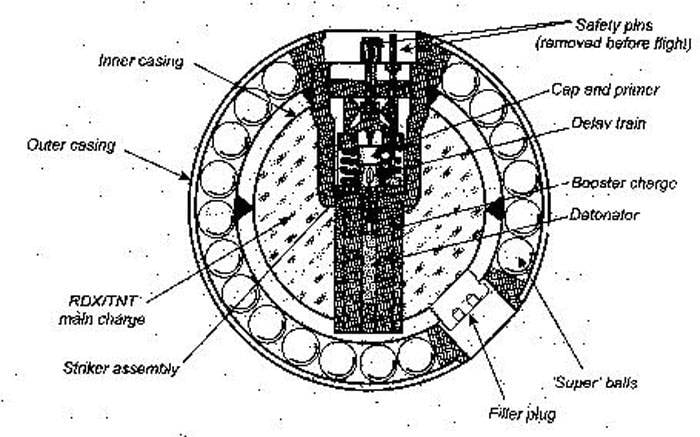
Bomb in section. Figure Saairforce.co.za
The warhead of the bomb, which is responsible for hitting targets, was to be a metal sphere filled with explosive and equipped with a decelerating fuse. On top of the main body, crushing into fragments, it was necessary to place a larger thin sphere. The space between the two buildings was planned to be filled with rubber balls of sufficient diameter. Petter-Bower, Denzil and Bev believed that a spherical bomb, after being dropped from an airplane, would lose speed and fly along a gentle trajectory. Falling to the ground, the product had to bounce off it and fly up again. For a more effective “reflection” from the surface, elastic balls were placed between the bodies. Only after climbing to a certain height should the explosion take place. During the fall and rebound of the bomb, the carrier managed to go a safe distance.
P. Petter-Bower had connections with the command of the Rhodesian army, and took advantage of this opportunity. The Alpha project was proposed to Air Force Commander Marshal Mick McLaren. In addition, he brought the layout of the future bomb to the marshal’s office. After studying the original design, the commander ordered to remove the product from the office, as well as continue work. Maclaren demanded that, in a month and a half, the first batch of bombs be made, sufficient to fully arm the four Canberra planes.
The author of the project indicated the lack of necessary funding, but the marshal promised to deal with this problem. Engineers were able to focus on design work, without being distracted by organizational issues. This allowed them to solve the task in a timely manner.
Soon the final appearance of the Alpha bomb was determined, after which the production of the first experimental batch for testing began. It is curious that with the design and testing of the design of the product has not changed. The general features of the bomb remained the same, while only a few of its individual elements underwent minor changes.
The largest element of the serial bomb was an external “soft” case with a diameter of 155 mm, stamped from steel sheet with a thickness of 3 mm. It consisted of two hemispheres that welded during the final assembly of the bomb. In the external sphere there were small hatches for the installation of the fuse and other operations. Directly under the outer casing, almost over its entire outer surface, there were 240 rubber balls with a diameter of about 20 mm. They served as a shock absorber, accumulating the energy of impact and helping the bomb to jump off the ground. Balls were absent only near the necks for the fuse and pouring the explosive.
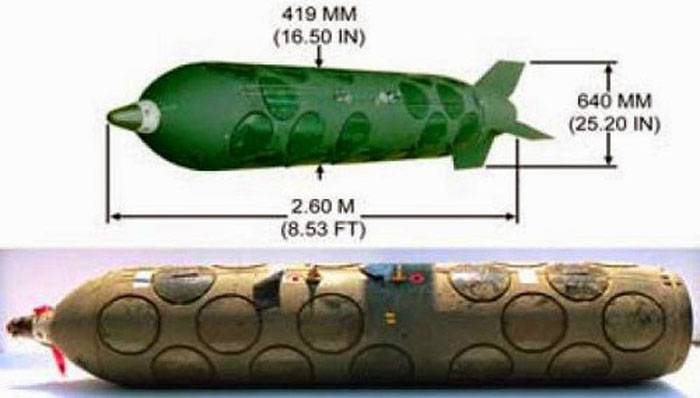
Container CB470. Photo Bayourenaissanceman.blogspot.fr
The inner case had walls 8 mm thick. Inside it was set a glass of variable cross section, intended for the fuse and detonator. The upper part of such glass protruded beyond the inner body and reached the outer one, allowing technicians to serve the fuse. Also in the inner case there was a hole for pouring explosives during manufacture. It was closed by its own stopper.
Alpha type bomb carried a charge in the form of TNT 680. It was proposed to carry out an explosion using a shock detonator with a delay. For safe handling, the fuse was equipped with a safety check, which should be removed when the bombs were loaded onto the aircraft. The design of the fuse was determined in such a way that it worked at any impact on the ground, regardless of the position of the bomb in space. Calculations showed that the best results of the bomb will show when the fuse is slowed down in 0,7 s.
Small size and weight, as well as the simplicity of the design allowed the use of new bombs in large quantities. It was proposed to load them into special containers placed in the cargo compartments of the aircraft carrier. The discharge of a large number of bombs was carried out simultaneously, by simply opening the doors of the bomb bay. Containers with a capacity of 50 bombs have been developed for use with Canberra aircraft. Each such bomber could carry six containers with a total ammunition in 300 bombs.
The ideal use of Alpha bombs, as conceived by the designers, was as follows. The Canberra carrier aircraft was supposed to fly at an altitude of 500 feet (152 m) at a speed of 300 nodes (555 km / h). Approaching the goal, the pilot had to open the containers and drop bombs. Spherical munitions quickly slowed by the oncoming flow and lagged behind the flying aircraft, reducing the risks to it. With reduced speed, he had to go along a gentle path and reach the ground.
When hitting the ground with a meeting angle of no more than a 15-17 degree bomb, using rubber balls, extinguished the blow, and then bounced upwards, continuing to move. At the moment of impact, the detonator fuse began to work. Over the 0,7 with between the strike and the ground and the explosion, the bomb managed to rise to a height of no more than 10 m and move away from the point of impact on the 18-20 m. After that, there was a blast in the air, which ensured the correct distribution of fragments over the surrounding space and increased the effectiveness of the munition.
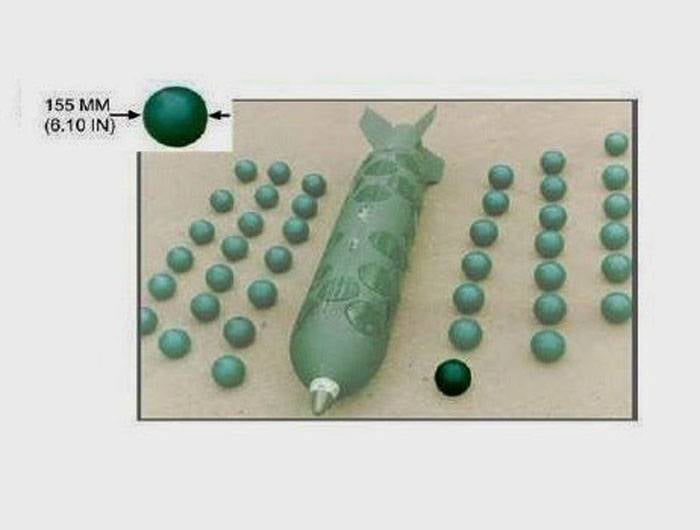
CB470 container and payload. Photo Bayourenaissanceman.blogspot.fr
A little ahead of schedule, Rhodesian experts prepared the first set of Alpha test bombs for use in trials. Three hundred of such products did not receive an explosive, instead of which concrete of the required mass was poured into them. In the course of the first tests, it was intended to determine the features of the release of bombs from the carrier's discharge chamber and the subsequent flight.
Already the first checks led to very interesting results. Thus, it was found that the test bombs could be used several times: after the first discharge, they had minor damage, and therefore a new test could take place without making a new batch. However, this was not the main achievement of the project.
Spherical aerial bombs, as required, slowed down noticeably during the fall and allowed the wearer to go a safe distance. In this case, the transverse dispersion of ammunition turned out to be even more calculated, which was considered a positive feature. It was soon determined that the sequential opening of six containers with 50 bombs each at intervals in 0,5-0,6 s, when flying at 500 feet with 300 nodes, allows the area to be covered with 700 meters and 100 widths. By changing the height and speed of flights , it was possible to influence the size of the attacked area.
Seven weeks after the start of design work, or a week after the deadline set by Marshal M. McLaren, the first test dump of Alpha bombs in combat configuration took place. On the site with a length of 1200 m and a width of 200 m placed a few hundred cardboard and metal targets, imitating manpower, equipment and materiel of the enemy. Only one Canberra bomber with a full load of Alpha products was to attack such a "base" of a conditional enemy. In confirmation of the already obtained characteristics of the bomb successfully hit almost all the existing targets. Calculations showed that an area of one square foot accounted for an average of one fragment.
The command that observed these tests was delighted and did not hesitate in terms. With strong words, the Alpha bomb was recommended for use. Soon, an official order appeared, in accordance with which this product was accepted by the security forces of Rhodesia under the official designation M2 Alpha. Previously, to ensure testing, a full-scale production of such bombs was deployed. After adoption, it continued, now in the interests of the Air Force. An important feature of serial bombs was their low cost. Alfa alone cost the army about $ 60-65 US dollars at current prices.
According to various sources, the Rhodesian aircraft repeatedly used new weapons during various conflicts and operations. Almost all story Rhodesia was associated with armed struggle, and the original light bombs clearly did not have to lie in warehouses. At the same time, however, accurate information about the combat use of such weapons is missing. Where, when, how and with what results it was used by the Air Force of Rhodesia - is unknown.
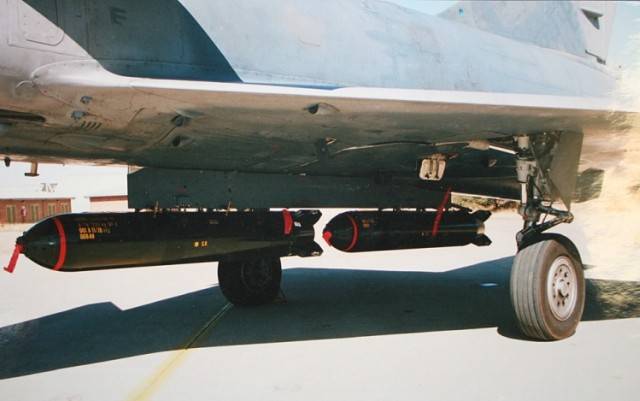
CB470 containers with Mk 2 Alpha bombs on the external load of an aircraft of the South African Air Force. Photo Bayourenaissanceman.blogspot.fr
In 1979, the unrecognized Rhodesia ceased to exist. The authors of the project “Alpha” and many other specialists of the Rhodesian defense industry preferred to go to the Republic of South Africa. At the new site, they continued the development of the existing project and supplemented the existing bomb with a new tool. The Mk 2 Alpha was used with containers that were compatible only with Canberra bombers. For the use of bombs with other aircraft, a universal container called CB470 was developed.
The container had a torpedo-shaped hull with a lively head fairing and an X-shaped tail. In the central part of the hull 40 cells for bombs covered with round covers were provided. After the container was dropped from the aircraft, the caps should have been released and flown, ensuring the release of four dozen bombs. The CB470 container had a length of 2,6 m with a body diameter of 419 mm. The span of the stabilizer is 640 mm. Universal mounts allowed to use such a device with any aircraft that have external or internal suspension components. The container could be dropped from a height of at least 30 m. In optimal conditions, it ensured the destruction of targets in a strip of length 250 m and width 70 m.
Bomb container for products Mk 2 Alpha was adopted by the South African Air Force in the early eighties. There is information on the use of such products in subsequent armed conflicts. However, this time too there is no detailed information on the operation of weapons.
In the early eighties, a number of Alpha bombs and CB470 containers were sold to Iraq, which at that time fought with Iran. Known about the use of such weapons in the Iran-Iraq war. In addition, according to available data, the Iraqi industry has launched the release of its own version of South African bombs. A significant number of such products remained in warehouses until the early nineties. During the Gulf War, coalition aircraft destroyed most of these stocks.
A curious story took place in the middle of the two thousandth. Investigating the captured objects of the Iraqi army, American troops found a number of strange round ammunition. They could not be identified immediately, and therefore in certain circles rumors spread about some secret and mysterious Iraqi weapons. Not all Rhodesian developments are known to the general public, which led to such amusing consequences. Later, the interested public nevertheless was able to identify in the mysterious Iraqi bombs bombs created by the specialists of Rhodesia.
Since the declaration of independence, Rhodesia has faced the most serious problems, including in the field of armaments and military equipment. The existing tasks had to be solved on their own, without outside help. At the same time, the most original and interesting ideas were often suggested. One of them was implemented in the project with the “Alpha” code and had a noticeable effect on the combat capability of the less developed Air Force.
On the materials of the sites:
http://ourstory.com/
http://saairforce.co.za/
https://bayourenaissanceman.blogspot.fr/
http://michaelyon-online.com/
Information